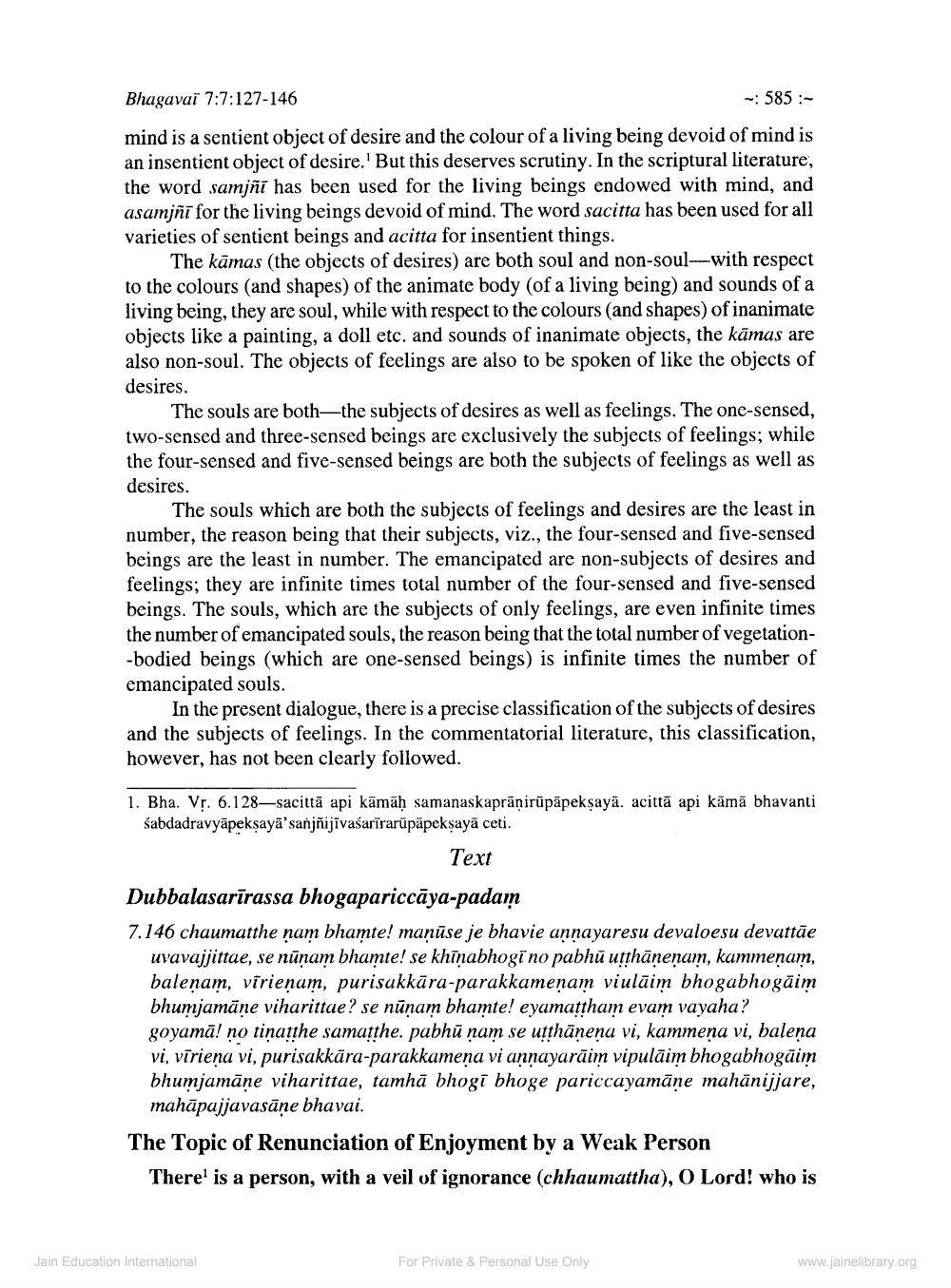________________
Bhagaval 7:7:127-146
~: 585
mind is a sentient object of desire and the colour of a living being devoid of mind is an insentient object of desire.' But this deserves scrutiny. In the scriptural literature, the word samjni has been used for the living beings endowed with mind, and asamjni for the living beings devoid of mind. The word sacitta has been used for all varieties of sentient beings and acitta for insentient things.
The kāmas (the objects of desires) are both soul and non-soul-with respect to the colours (and shapes) of the animate body (of a living being) and sounds of a living being, they are soul, while with respect to the colours (and shapes) of inanimate objects like a painting, a doll etc. and sounds of inanimate objects, the kamas are also non-soul. The objects of feelings are also to be spoken of like the objects of desires.
The souls are both the subjects of desires as well as feelings. The one-sensed, two-sensed and three-sensed beings are exclusively the subjects of feelings; while the four-sensed and five-sensed beings are both the subjects of feelings as well as desires.
The souls which are both the subjects of feelings and desires are the least in number, the reason being that their subjects, viz., the four-sensed and five-sensed beings are the least in number. The emancipated are non-subjects of desires and feelings; they are infinite times total number of the four-sensed and five-sensed beings. The souls, which are the subjects of only feelings, are even infinite times the number of emancipated souls, the reason being that the total number of vegetation-bodied beings (which are one-sensed beings) is infinite times the number of emancipated souls.
In the present dialogue, there is a precise classification of the subjects of desires and the subjects of feelings. In the commentatorial literature, this classification, however, has not been clearly followed.
1. Bha. Vr. 6.128-sacittā api kāmāḥ samanaskaprāṇirūpāpekṣayā. acitta api kāmā bhavanti Sabdadravyāpekṣayā”sanjñijīvasarīrarūpāpekṣayā ceti.
Text
Dubbalasarirassa bhogapariccaya-padam
7.146 chaumatthe nam bhamte! manuse je bhavie annayaresu devaloesu devattãe uvavajjittae, se nūņam bhamte! se khīṇabhogī no pabhū uṇṭhāṇeņam, kammeṇam, balenam, vīrieṇam, purisakkāra-parakkameņam viulaim bhogabhogaim bhumjamāne viharittae? se nunam bhamte! eyamattham evam vayaha? goyamā! no tinaṇthe samatthe. pabhu nam se uṭṭhāneṇa vi, kammeņa vi, baleṇa vi, vīrieņa vi, purisakkāra-parakkameņa vi anṇayarāim vipulāim bhogabhogāim bhumjamāne viharittae, tamha bhogi bhoge pariccayamāṇe mahānijjare, mahāpajjavasāne bhavai
The Topic of Renunciation of Enjoyment by a Weak Person
There' is a person, with a veil of ignorance (chhaumattha), O Lord! who is
Jain Education International
For Private & Personal Use Only
www.jainelibrary.org




